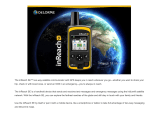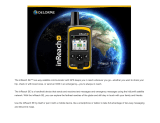
Table of contents
Getting started................................................................ 1
Device Overview......................................................................... 1
Turning the device on or off........................................................ 1
Acquiring GPS signals................................................................ 1
Status bar icons.......................................................................... 1
Using the on-screen buttons....................................................... 1
Adjusting the volume.................................................................. 1
Using the audio mixer............................................................ 1
Adjusting the screen brightness................................................. 1
Transportation modes................................................................. 1
Choosing a Transportation Mode.......................................... 2
Using the Large Button Keyboard.............................................. 2
Installation...................................................................... 2
Mounting your device in a motorcycle........................................ 2
Powered Motorcycle Mount................................................... 2
Installing the Handlebar Base................................................ 2
Attaching the Power Cables to the Motorcycle Mount........... 2
Attaching the Base Plate to the Motorcycle Mount................ 2
Attaching the Base Plate to the Handlebar Base................... 3
Installing your device in the motorcycle mount...................... 3
Removing Your Device from the Motorcycle Mount................... 3
Mounting Your Device in an Automobile.................................... 3
Rider Awareness Features and Alerts.......................... 3
Enabling or Disabling Rider Alerts.............................................. 4
Red light and speed cameras..................................................... 4
Incident Detection and Notifications........................................... 4
Setting Up an Incident Contact.............................................. 4
Cancelling an Incident Notification......................................... 4
Disabling Incident Notifications.............................................. 4
inReach Remote......................................................................... 4
Connecting an inReach Device............................................. 4
Sending an inReach Message............................................... 4
SOS....................................................................................... 5
Viewing Helmet Law Notifications...............................................5
Searching for Helmet Laws.........................................................5
Navigating to your destination...................................... 5
Routes........................................................................................ 5
Starting a route........................................................................... 5
Taking a Route Using Garmin Adventurous Routing™......... 5
Changing the route calculation mode.................................... 5
Starting a route by using the map.......................................... 5
Going home........................................................................... 6
Your route on the map................................................................ 6
Active lane guidance.............................................................. 6
Viewing turns and directions.................................................. 6
Viewing the Entire Route on the Map.................................... 6
Arriving at your destination......................................................... 6
Parking Near Your Destination.............................................. 6
Changing Your Active Route...................................................... 6
Adding a location to your route.............................................. 6
Shaping Your Route...............................................................7
Taking a detour...................................................................... 7
Stopping the route...................................................................... 7
Avoiding Delays, Tolls and Areas............................................... 7
Avoiding traffic delays on your route...................................... 7
Avoiding toll roads..................................................................7
Avoiding toll stickers.............................................................. 7
Avoiding road features........................................................... 7
Custom avoidances............................................................... 7
Navigating off road......................................................................8
Fuel tracking............................................................................... 8
Enabling fuel tracking.............................................................8
Setting a low-fuel warning...................................................... 8
Resetting the Fuel Tank Mileage
........................................... 8
Enabling dynamic fuel stops.................................................. 8
Finding and saving locations........................................ 8
Finding a location using the search bar...................................... 8
Points of Interest......................................................................... 8
Finding a location by category.................................................... 8
Navigating to points of interest within a venue...................... 9
Viewing Your Garmin Explore™ Points of Interest..................... 9
Synchronising Garmin Explore Account Data........................ 9
Location Search Results............................................................. 9
Location Search Results on the Map..................................... 9
Changing the search area.......................................................... 9
Parking........................................................................................9
Finding Parking Near Your Current Location......................... 9
Finding Parking Near a Specified Location.......................... 10
Understanding Parking Colours and Symbols..................... 10
Search tools.............................................................................. 10
Finding an address.............................................................. 10
Finding a junction................................................................. 10
Finding a location using coordinates................................... 10
Finding HISTORY® points of interest....................................... 10
Foursquare............................................................................... 10
Connecting to your Foursquare account.............................. 10
Searching Foursquare points of interest.............................. 10
Viewing Foursquare location details.................................... 10
Checking in with Foursquare............................................... 10
TripAdvisor®............................................................................. 10
Finding TripAdvisor points of interest...................................10
Viewing history..........................................................................10
Clearing the list of recently found places............................. 10
Viewing current location information......................................... 11
Finding emergency services and fuel.................................. 11
Getting directions to your current location........................... 11
Adding a shortcut...................................................................... 11
Removing a shortcut............................................................ 11
Saving Locations...................................................................... 11
Saving a location..................................................................11
Saving your current location................................................ 11
Editing a favourite location................................................... 11
Assigning categories to a saved location............................. 11
Deleting a favourite location................................................ 11
Using the Map............................................................... 11
Map Tools................................................................................. 11
Viewing a map tool...............................................................12
Up ahead.................................................................................. 12
Viewing upcoming locations.................................................12
Customising the up ahead categories................................. 12
Towns Ahead............................................................................ 12
Viewing Upcoming Towns and Exit Services....................... 12
Trip information......................................................................... 12
Viewing trip data from the map............................................ 12
Viewing the trip information page........................................ 12
Resetting trip information..................................................... 12
Viewing upcoming traffic........................................................... 12
Viewing traffic on the map....................................................12
Searching for traffic incidents...............................................12
Customising the map................................................................ 13
Customising the map layers.................................................13
Changing the map data field................................................ 13
Changing the map perspective............................................ 13
Live services, traffic and smartphone features......... 13
Bluetooth Feature status icons................................................. 13
Pairing Your Phone and Headset............................................. 13
Smart Notifications....................................................................13
Receiving notifications......................................................... 13
Table of contents i






















